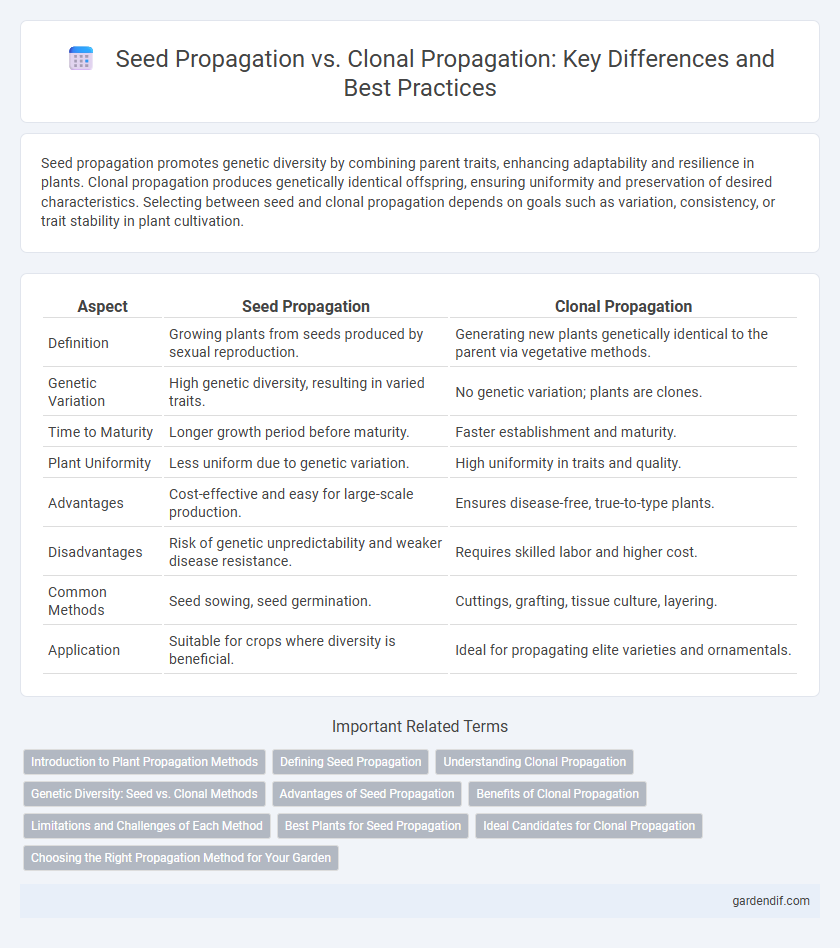
Seed Propagation vs Clonal Propagation Illustration
Seed propagation promotes genetic diversity by combining parent traits, enhancing adaptability and resilience in plants. Clonal propagation produces genetically identical offspring, ensuring uniformity and preservation of desired characteristics. Selecting between seed and clonal propagation depends on goals such as variation, consistency, or trait stability in plant cultivation.
Table of Comparison
| Aspect | Seed Propagation | Clonal Propagation |
|---|---|---|
| Definition | Growing plants from seeds produced by sexual reproduction. | Generating new plants genetically identical to the parent via vegetative methods. |
| Genetic Variation | High genetic diversity, resulting in varied traits. | No genetic variation; plants are clones. |
| Time to Maturity | Longer growth period before maturity. | Faster establishment and maturity. |
| Plant Uniformity | Less uniform due to genetic variation. | High uniformity in traits and quality. |
| Advantages | Cost-effective and easy for large-scale production. | Ensures disease-free, true-to-type plants. |
| Disadvantages | Risk of genetic unpredictability and weaker disease resistance. | Requires skilled labor and higher cost. |
| Common Methods | Seed sowing, seed germination. | Cuttings, grafting, tissue culture, layering. |
| Application | Suitable for crops where diversity is beneficial. | Ideal for propagating elite varieties and ornamentals. |
Introduction to Plant Propagation Methods
Seed propagation involves growing plants from seeds, ensuring genetic diversity and adaptability, making it ideal for crop improvement and breeding programs. Clonal propagation produces genetically identical offspring through methods like cuttings, grafting, or tissue culture, guaranteeing uniformity and preserving desirable traits. Understanding these fundamental plant propagation methods is essential for optimizing agricultural productivity and horticultural practices.
Defining Seed Propagation
Seed propagation refers to the reproduction of plants through the germination of seeds, ensuring genetic diversity and adaptability in offspring. This method relies on sexual reproduction, where pollen fertilizes ovules to produce viable seeds that develop into new plants. Seed propagation is widely used in agriculture and horticulture for growing crops, flowers, and trees, promoting robust plant populations with varied traits.
Understanding Clonal Propagation
Clonal propagation involves producing genetically identical plants from a single parent through methods such as cuttings, grafting, or tissue culture, ensuring uniformity and preserving desirable traits. This technique bypasses genetic variation common in seed propagation, leading to consistent crop quality and faster multiplication of elite cultivars. It is widely used in horticulture and agriculture for crops like fruit trees, potatoes, and ornamental plants where maintaining genetic fidelity is crucial.
Genetic Diversity: Seed vs. Clonal Methods
Seed propagation promotes genetic diversity by combining genetic material from two parent plants, resulting in offspring with varied traits that enhance adaptability and disease resistance. In contrast, clonal propagation produces genetically identical plants through methods such as cuttings, grafting, or tissue culture, preserving desirable traits but limiting genetic variability. This reduced diversity in clonal propagation can increase vulnerability to pests and environmental changes, whereas seed propagation supports evolutionary potential and ecosystem resilience.
Advantages of Seed Propagation
Seed propagation enables genetic diversity, enhancing plant resilience to diseases and environmental changes while promoting natural adaptation. It is cost-effective and widely accessible, requiring minimal specialized equipment compared to clonal propagation. Seedlings often establish stronger root systems, improving overall plant vigor and long-term survival rates.
Benefits of Clonal Propagation
Clonal propagation ensures genetic uniformity by producing identical plants, maintaining desired traits such as disease resistance and fruit quality. This method accelerates crop production cycles and increases yield consistency compared to seed propagation. Enhanced reliability in growth performance makes clonal propagation ideal for commercial agriculture and horticulture industries.
Limitations and Challenges of Each Method
Seed propagation often results in genetic variation, leading to inconsistent plant traits and longer maturation periods, which can be problematic for uniform crop production. Clonal propagation, while producing genetically identical plants, faces challenges such as vulnerability to diseases, high propagation costs, and the requirement for specialized techniques and equipment. Both methods present limitations in scalability and resource management, influencing their suitability based on agricultural goals and environmental conditions.
Best Plants for Seed Propagation
Seed propagation is ideal for plants such as tomatoes, sunflowers, and marigolds, which exhibit vigorous growth and genetic diversity through seeds. Hardy annuals, vegetables, and many herbaceous perennials typically respond well to seed propagation, ensuring healthy root systems and adaptability. In contrast, clonal propagation suits plants requiring identical genetic copies, but seed propagation remains superior for species with strong seed viability and rapid germination rates.
Ideal Candidates for Clonal Propagation
Ideal candidates for clonal propagation include plants with desirable traits that need to be preserved, such as fruit trees, flowering shrubs, and certain vegetables. Clonal propagation ensures genetic uniformity, making it optimal for cultivars that do not breed true from seeds or have low seed viability. This method is especially beneficial for rare or hybrid plants that require consistent quality and performance.
Choosing the Right Propagation Method for Your Garden
Seed propagation offers genetic diversity, which enhances plant resilience and adaptability, making it ideal for creating new plant varieties and supporting long-term garden health. Clonal propagation ensures uniformity and preserves desirable traits, perfect for replicating specific plants with known characteristics or maintaining consistent quality. Selecting the right method depends on whether the goal is genetic variation or uniformity, as well as factors like species type, growth rate, and maintenance ease.
Seed Propagation vs Clonal Propagation Infographic

 gardendif.com
gardendif.com